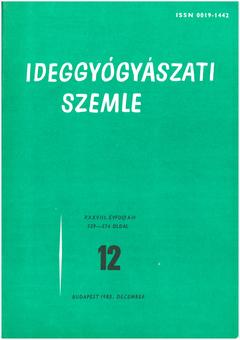The eLitMed.hu medical portal uses computer cookies for convenient operation. Detailed information can be found in the Cookie-policy.
Clinical Neuroscience - 1985;38(12)
Content
[Our experience with quantitative analysis of EEG reactivity I. Spectral analysis ]
[Our studies show that the synchronization and desynchronization of EEG background activity changes in response to barbiturate anesthesia can be distinguished from each other by our spectral analysis procedure. We found that the synchronization response is characterized by a larger magnitude increase in power in the theta, alpha and beta bands, and desynchronization by a larger magnitude decrease in power in the theta and alpha bands. Our results are consistent with previous visual observation, although we also obtained data on the importance of newer elements, changes in power in the beta and theta bands, in the synchronization process. ]
[Our experience with quantitative analysis of EEG reactivity II. Period and amplitude analysis]
[Our studies show that period and amplitude analysis can be used to distinguish between the two types of background activity changes induced by stimulation - synchronization and desynchronization - but this procedure does not provide as accurate an insight into the details of what is happening as spectral analysis of the same material. Also with this method, the changes in the theta and alpha bands were found to be the most useful for separating the two types of reactions; the synchronisation response could be characterised by an increase in the total wave area detected in these bands, but this procedure, due to its technical limitations, did not sufficiently reflect the faster elements superposed on the fundamental rhythm and this led to an unsatisfactory detection of the beta band changes. In our opinion, this can also explain the fact that the reclassification of our parameters obtained by period and amplitude analysis after discriminant analysis revealed significantly more synchronization responses that were not visually classified - i.e., incorrectly detected. ]
[Our experience with quantitative analysis of EEG reactivity III. Hjorth parameter analysis ]
[Our results suggest that our Hjorth parameters, estimated by the simplified method of Saltzberg and Burch, and the derivatives describing their changes over time, can be used to characterize and detect changes in synchronization and desynchronization background activity in humans induced by stimulation. The results obtained in response pattern recognition approached those obtained in our studies with spectral analysis and were superior to those obtained with period and amplitude analysis. This procedure, in contrast to the latter, tended to lead to misidentification of desynchronisation responses, but the difference between the two types of misidentification was not significant, according to our tests. Our experience shows that the synchronization response was characterized by a more pronounced increase in the Activity parameter and a significant decrease in the Mobility parameter. This confirmed the previous observations on the two types of reactivity responses, but in addition, our data also drew attention to the importance of the common - yet unclear - components of these background activity changes. ]
[Reasons for lack of cooperation with medication in schizophrenic patients ]
[The authors examined the relationship between subjective response to neuroleptic treatment and compliance in 51 schizophrenic patients. 47% of the patients subjectively perceived the treatment as unpleasant and 79% of them belonged to the group of treatment non-compliant. No association was found between subjective response and current side effects. It was confirmed that among the psychopathological symptoms observed at discharge, delusions of grandiosity and lack of illness awareness were risk factors for noncompliance. However, a higher degree of depression as measured by self-assessment was more likely to be associated with a more favorable interaction with treatment.]
[Report]
[The author reports on the XI Congress of Psychotherapy of the Medical Psychotherapeutic Society of the GDR.]
1.
Clinical Neuroscience
[Headache registry in Szeged: Experiences regarding to migraine patients]2.
Clinical Neuroscience
[The new target population of stroke awareness campaign: Kindergarten students ]3.
Clinical Neuroscience
Is there any difference in mortality rates of atrial fibrillation detected before or after ischemic stroke?4.
Clinical Neuroscience
Factors influencing the level of stigma in Parkinson’s disease in western Turkey5.
Clinical Neuroscience
[The effects of demographic and clinical factors on the severity of poststroke aphasia]1.
2.
3.
4.
5.



